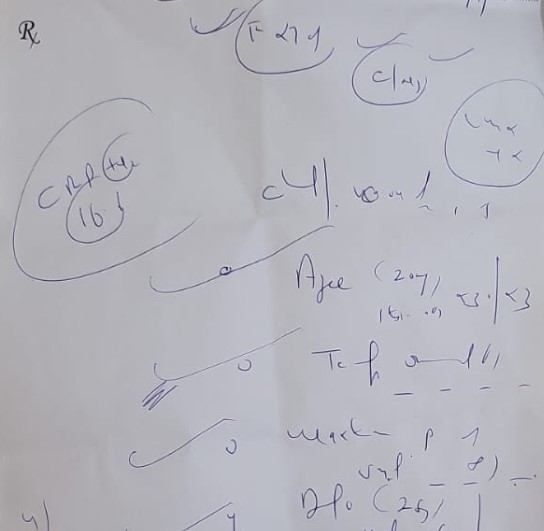Despite clear guidelines of the Union government and the UT administrations, a majority of doctors in J&K continue to write illegible prescriptions, putting attendants to inconvenience and threatening patients’ lives.
By Ajaz Rashid
One recent winter afternoon, Yawar Iqbal walked into a top pharmacy in Jammu city with a prescription letter of a paediatrician for his six-year-old daughter who had a high-grade fever with a cold and persistent cough. The Prescription Problem
But the pharmacist told him that the stock of the prescribed medicines had run out, “I couldn’t make sense of the doctor’s handwriting and asked the pharmacist for the names of medicines, so that I could buy elsewhere or perhaps order online,” Iqbal, a businessman based in Srinagar city said.
However, the pharmacist avoided the questions and turned to the next customer, “I visited at least four more pharmacies in the Jammu region but all of them had the same answer – that the stock had run out,” he said.
After consulting friends in Srinagar and a few WhatsApp exchanges later, Iqbal was able to figure out the names of the medicines. “When I went back to the pharmacy and looked for medicines instead of what was written on the prescription, all the medicines were readily available,” Iqbal, who travels often between Jammu and Srinagar, told Kashmir Scan.

According to rules, a doctor’s prescription has his or her name along with the name of the patient, the date on which it was issued to the patient, the medical history of the patient and diagnosis made along with the name of medicines prescribed, their route of administration, dosage, time and duration.
Many times, it may include an order for a plan of tests, procedures, and operations. Thus, the prescription is the most important piece of paper which patients possess for obtaining relief or cure from their suffering, said Prof Mohammad Sultan Khuroo, a top scientist and one of India’s foremost medical practitioners based in Srinagar.
In his handbook, ‘Dr.Khuroo’s Common Topics on Health & Healthcare’, the former SKIMS director observes that a prescription is made of four parts – superscription, inscription, subscription, and signature.
The superscription is the identification of the patient, vital status, clinical syndromes, and physical and patient events that guard the physician to choose the correct drug/s and its dose.

“Inscription usually includes the chief drug intended to cure, an additional drug to assist the chief drug, and a supplement (corrective drug) to prevent the adverse effects of the drug,” Dr Khuroo writes in his book.
The subscription describes the dispensing directions in Latin symbols [qd, od, bid, tid, qid, po, hs, etc] or in English while the signature is usually used for patient directions, including his or her schedule for the ‘Return to Clinic’ order. It ends with a sign from the doctor, the author notes.
All these details are supposed to be noted in legible terms so that there is prompt and ready access to the vital status of a patient, his medical history, and drug intake in case of an emergency situation.
Some years ago, there were widespread rumours in Jammu and Kashmir that there was a deep nexus between the pharmaceutical companies, medical representatives, pharmacists, and doctors to ensure that only a select brand of drugs were sold to customers.
It was widely believed that the doctors were issuing prescriptions in distorted handwriting so that only a select group of pharmacies could decipher the names of medicines and only a particular brand of medicines were sold.
In 2015, the Union Health Ministry brought in a gazette notification by amending rules in the Indian Medical Council Regulations, 2002, under which the physicians were directed to prescribe drugs with generic names in legible and capital letters.

The then Union Health Minister JP Nadda had in the Lok Sabha said that illegible prescriptions by doctors may lead to serious implications and even death.
However, the gazette notification and the change in law has failed to translate into action, especially in Jammu and Kashmir, where doctors continue to prescribe branded drugs instead of generic drugs in handwriting which is illegible in most of cases.
A doctor at SMHS hospital, who didn’t want to be named, said that the nexus between big Pharma companies and regulating bodies has blockaded the implementation of generic drugs policy, “But it still remains a mystery as to what is stopping the government from holding the doctors accountable who don’t write legible prescriptions,” he said.
“If a patient with throat infection is mistakenly given drugs used for cancer treatment, he or she can actually die,” the doctor added.
The absence of an enforcement mechanism or a regulatory body to ensure that the doctors are following the rules translates into misery for patients who are left clueless about the line of treatment adopted by medical practitioners.
“It’s a frustrating experience. On one hand, a person is dealing with the trauma of caring for a sick person and on the other hand, he or she is unable to find medicines because we can’t figure out the prescription letter,” said Aamir Ganai, who owns a pharmacy in central Kashmir’s Budgam district.
Last year, J&K’s Health and Medical Education Department set up a Prescription Audit Committee (PAC) at all the government health institutions such as Government Medical College, district and sub-district hospitals across the Union Territory. The committees were tasked to collect at least one percent random photocopies of prescriptions written by doctors in OPDs.
“These prescriptions shall be scrutinized by the Prescription Audit committees to check whether the prescriptions are written legibly in Capital Letters with the name of the doctors, his/her signatures and registration number, generic drugs are prescribed and preference given to the drugs which are available free in the Hospital supplies, unnecessary diagnostics test are not prescribed and patients are not referred to private clinics/specialists without requirement and whether drugs are prescribed in contravention to the provision of Drug and Cosmetics Act and Regulations,” an order issued by the Health and Medical Education Department said.

“It shall be again ensured by the prescription audit committee that fortnightly reports are sent to the HODs. HODs shall prepare a comprehensive monthly report along with their recommendation highlighting the actionable points, which shall be submitted to the Administrative Department,” the order added.
However, even though doctors continue to prescribe branded drugs in illegible handwriting, the administrative department of the Health and Medical Education Department has not publicly taken any action against the offenders, leaving patients in flux. A senior official in the department said that the PAC wasn’t “dysfunctional”. “These are toothless tigers. Since their inception, the committees have failed to do their job,” said the official, requesting anonymity.

[…] for themselves, having completed his MBBS from ASCOMS Jammu and post-graduation in Anaesthesia from Government Medical College (GMC), Srinagar. His dedication to his craft and unwavering commitment to his patients make him a […]